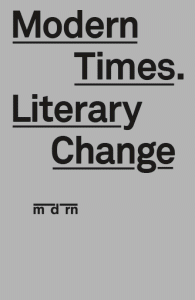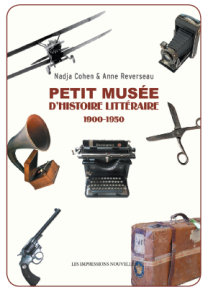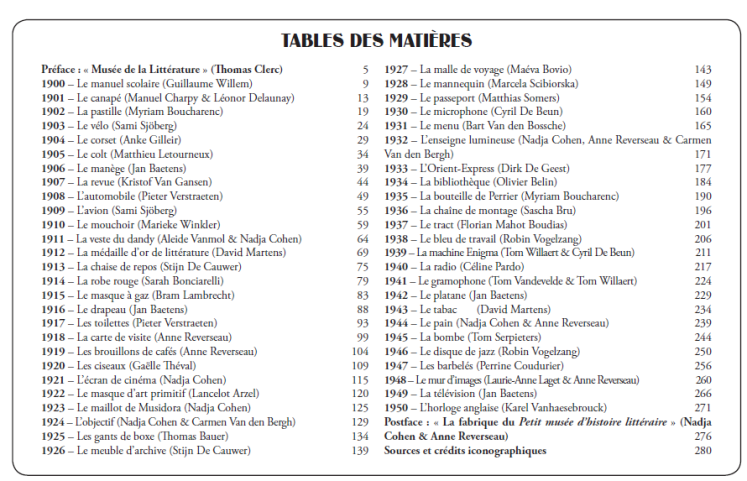
In the little and smartly designed booklet Modern Times. Literary Change (2013) written by the members of the Leuven based research group MDRN it is stated that literary history is again at the heart of literary studies. As such it responds to a need felt both inside and outside academia for new historical accounts of literature. Yet, literary history remains a difficult genre: ‘While there is a consensus on its necessity, there is arguably no agreement on how to write it.’ (p.9)
In the ‘ABC of Literary History’, the manifesto that opens the book, several reasons are addressed that make the writing of literary history such a difficult task. One of the reasons is the fact that our conceptions of literature – as well as the way we use literary texts and appreciate them – are always linked to the social-historical and cultural context in which we are working. This is why our views and ideas on literature change all the time and why literary historiography was, and still is, ‘more norm-governed and more normative then we usually like to admit.’ (p.11)
Because there is nothing inherent to literature that determines what literature is (and what it is not), literature is not something that simply ‘exists’, according to the writers, but something that ‘becomes’. Therefore, Modern Times. Literary Change argues for a functionalistic approach. That is, an approach in which we no longer need to study literature’s properties (what is literature?), but its functionalities: how do people make use of literature? To what end? And what is the effect of the different uses of literature?
The proposed direction bears resemblance to the view expressed for example by Robert Hodge in Literature as Discourse (1990). In this book Hodge states that if notions like literature or history ‘cannot be accepted as absolute truths, at least they can be usefully studied as social facts.’ (p.17) Bearing this conviction in mind the attention of the literary historian drifts from literature to literary strategies, opening up the scope of literary studies towards the analysis of the discourse and practices of non-specialized and non-highbrow readers, to the study of modern rhetoric or peripheral ‘literary’ genres such as the speech or interview, or to the way authors, through their writings, reflect on new technologies that change our perception of time and place, of sound and vision. At least, these are the examples presented in Modern Times. Literary Change, but as the writers of the ‘ABC of Literary History’ add in the last sentence of their manifesto: ‘There might be many’.
It is likely that one can encounter some challenging proposals and demonstrations of concrete new models of writing literary history during the MDRN Writing Literary History Conference that will take place from the 14th till the 16th of September. I am already looking forward!
See here for the Call for Papers. Deadline 4th of May.
 Bij uitgeverij Les Impressions Nouvelle verscheen onlangs de ongewone literatuurgeschiedenis Petit musée d’histoire littéraire (redactie Nadja Cohen en Anne Reverseau). Aan de hand van beschrijvingen van objecten biedt het boek een blik op de literaire verbeelding in de periode 1900 tot 1950. Het gaat om de beschrijvingen van alledaagse objecten zoals de fiets, de ligstoel, het toilet; om herkenbare schrijversattributen zoals de typemachine en het tijdschrift; en om typische modernistische uitvindingen zoals het vliegtuig, de grammofoon, de radio. Door het prisma van de objecten beziet Petit musée d’histoire littéraire de technologische en maatschappelijke ontwikkelingen tussen 1900 en 1950. De schrijver wordt daarbij opgevoerd als bevoorrechte ooggetuige van de sociale en politieke veranderingen in deze turbulente periode.
Bij uitgeverij Les Impressions Nouvelle verscheen onlangs de ongewone literatuurgeschiedenis Petit musée d’histoire littéraire (redactie Nadja Cohen en Anne Reverseau). Aan de hand van beschrijvingen van objecten biedt het boek een blik op de literaire verbeelding in de periode 1900 tot 1950. Het gaat om de beschrijvingen van alledaagse objecten zoals de fiets, de ligstoel, het toilet; om herkenbare schrijversattributen zoals de typemachine en het tijdschrift; en om typische modernistische uitvindingen zoals het vliegtuig, de grammofoon, de radio. Door het prisma van de objecten beziet Petit musée d’histoire littéraire de technologische en maatschappelijke ontwikkelingen tussen 1900 en 1950. De schrijver wordt daarbij opgevoerd als bevoorrechte ooggetuige van de sociale en politieke veranderingen in deze turbulente periode.
